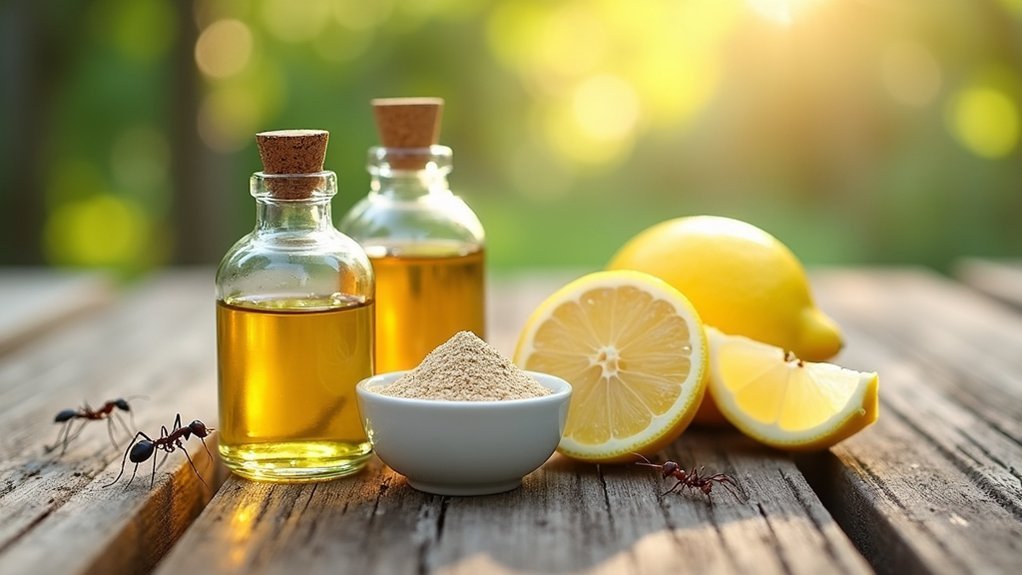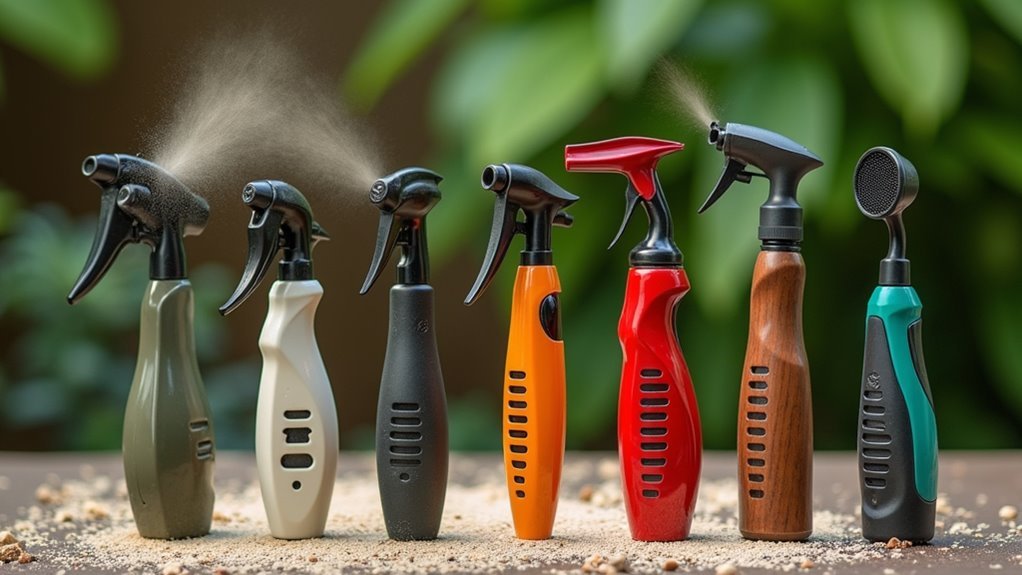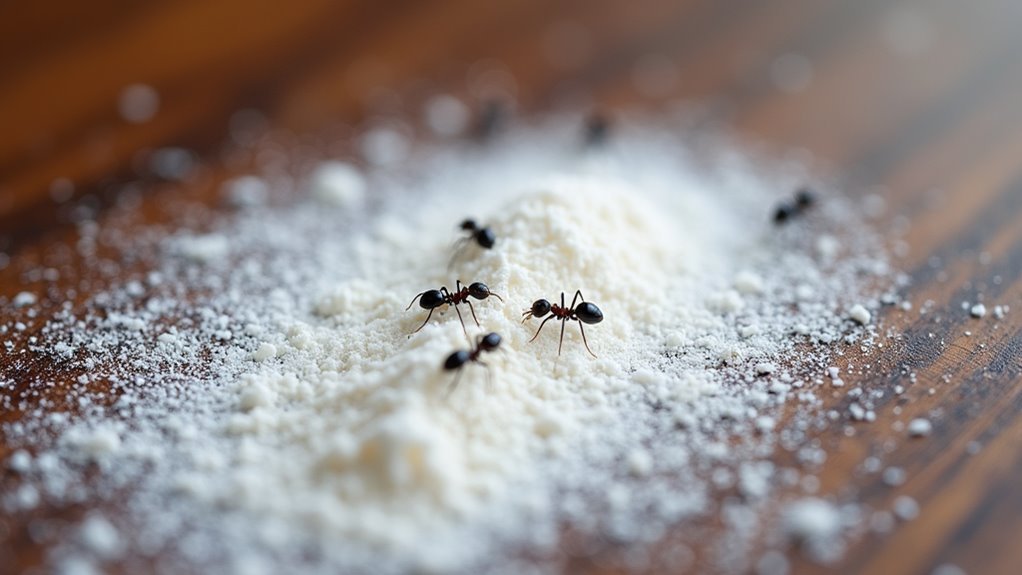Protecting your wooden structures from carpenter ants doesn’t require harsh chemicals that harm the environment. You’ve likely noticed those tiny sawdust piles or heard faint rustling in your walls—telltale signs of these destructive insects. While conventional pesticides work, they often contain toxins that linger in your home and soil for years. Natural alternatives can be just as effective without the environmental drawbacks. Let’s explore three eco-friendly solutions that will safeguard your wood and give you peace of mind.
Spectracide Terminate Termite & Carpenter Ant Killer Spray (1.33 Gallon)
Homeowners battling persistent carpenter ant infestations will find Spectracide Terminate offers powerful control while still meeting EPA standards for residential use. This ready-to-use 1.33-gallon solution kills wood-destroying insects on contact with its Lambda-Cyhalothrin formula.
You’ll appreciate the AccuShot sprayer with its continuous spray feature and ergonomic grip for precise application. The clear, non-staining formula leaves no odor and provides up to 9 months of indoor protection.
Apply it around foundations, wooden structures, and indoor problem areas like baseboards and plumbing spaces. With 11,918 positive ratings, this 12.3-pound solution delivers reliable performance for protecting your home from carpenter ants.
Best For: Homeowners seeking a powerful, long-lasting solution for wood-destroying pests like termites and carpenter ants with an easy application system for both indoor and outdoor use.
Pros:
- Versatile application with the AccuShot continuous sprayer system that features an ergonomic grip and extendable wand for hard-to-reach areas
- Provides extended protection with residual control lasting up to 9 months indoors against multiple pest types
- Clear, non-staining formula that leaves no lingering odor, making it suitable for indoor application without cosmetic concerns
Cons:
- Relatively heavy at 12.3 pounds when full, which may make it cumbersome for extended application sessions
- While effective against many pests, some users may require specialized products for severe termite infestations
- At 1.33 gallons, it may be more product than needed for small, isolated pest problems, resulting in potential waste
TERRO Ant Killer Bait Stations (12 Count)
When you’re seeking an effective solution for household ant invasions, TERRO Ant Killer Bait Stations offer a straightforward, ready-to-use option that relies on borax as its active ingredient. These American-made bait stations work by attracting ants who then carry the poison back to their colony, eliminating both visible and hidden populations.
You’ll notice results within days as ants diminish considerably. Simply place the stations near ant trails, corners, or baseboards. With a 4.6-star rating from over 130,000 customers, TERRO has earned its #1 bestseller status. While primarily targeting sweet-eating ants, many users report success with various household species, including carpenter ants.
Best For: Homeowners dealing with indoor ant infestations who prefer a non-spray, ready-to-use solution that eliminates the entire colony rather than just visible ants.
Pros:
- Highly effective formula with borax attracts ants and eliminates the entire colony including the queen
- Easy to use with pre-filled, ready-to-place stations requiring no mixing or preparation
- Exceptional customer satisfaction with 4.6/5 stars from over 130,000 reviews and #1 bestseller status
Cons:
- Initially attracts more visible ants to the bait stations before population decline begins
- Complete elimination can take up to two weeks for severe infestations
- Limited to targeting primarily sweet-eating ant varieties rather than all ant species
Nisus Tim-BOR Professional Insecticidal Dust for Termites and Wood Decay
Environmentally conscious DIYers seeking a versatile solution for carpenter ant infestations will find Nisus Tim-BOR Professional Insecticidal Dust particularly valuable. This 1.5-pound water-soluble borate powder offers remarkable flexibility, as you can apply it as dust, liquid, foam, or mist.
The eco-friendly formula contains disodium octaborate tetrahydrate, a naturally derived mineral that effectively combats carpenter ants while preventing wood decay. You’ll appreciate its non-corrosive properties—it won’t discolor or stain your wood surfaces.
For best results, mix with warm water or add ethylene glycol to enhance penetration. Remember to wear a mask during application to protect yourself.
Best For: Environmentally conscious homeowners and DIY enthusiasts looking for a versatile, non-toxic solution to effectively prevent and treat carpenter ant infestations and wood decay in residential settings.
Pros:
- Multi-application versatility allowing for use as dust, liquid, foam, or mist, making it adaptable to different types of infestations and hard-to-reach areas
- Eco-friendly formulation derived from natural borate minerals that’s non-corrosive and won’t discolor or stain wood surfaces
- Long-lasting protection against multiple wood-destroying organisms including carpenter ants, termites, beetles, and fungi in a single product
Cons:
- Requires personal protective equipment (mask) during application, which may be inconvenient for some users
- Needs to be mixed with warm water or ethylene glycol for optimal performance, adding an extra preparation step
- May not be suitable for use on painted or sealed surfaces, limiting application in some finished areas of the home
Factors to Consider When Choosing Eco-Friendly Carpenter Ant Solutions That Protect Wood Naturally
When choosing eco-friendly solutions to protect your wood from carpenter ants, you’ll need to evaluate the safety of active ingredients and how long the protection lasts. You should consider whether the product targets only carpenter ants or a broader range of pests, and if it’s suitable for indoor use, outdoor use, or both. The simplicity of application methods matters too, especially if you’re planning to apply the treatment yourself rather than hiring professionals.
Active Ingredient Safety
Three essential factors determine the safety profile of active ingredients in eco-friendly carpenter ant solutions. First, consider the toxicity level—natural compounds like borates provide effective protection against wood-destroying insects while maintaining low toxicity to humans and pets, making them ideal for indoor use.
Second, evaluate environmental impact. Unlike traditional sprays containing Lambda-Cyhalothrin that can harm non-target species, water-soluble borate powders offer targeted protection without damaging surrounding ecosystems.
Finally, assess long-term effects. The best eco-friendly solutions penetrate wood fibers deeply, remaining non-corrosive and non-staining while providing lasting protection. You’ll want products that combat carpenter ants effectively without leaving harmful residues. By prioritizing these safety factors, you’re choosing solutions that protect both your home and the environment.
Residual Protection Duration
Residual protection determines how long your eco-friendly carpenter ant solution will actively defend your home after application. Top-performing natural formulations can provide up to 9 months of indoor protection, reducing the need for frequent reapplications.
Look for borate-based products that offer dual benefits—they don’t just eliminate pests but also shield wood surfaces against decay and future infestations. Remember that environmental conditions greatly impact longevity; high humidity, extreme temperatures, and direct sunlight can degrade even the most durable solutions.
You’ll maximize protection duration through proper application techniques. Guarantee thorough coverage of vulnerable areas, particularly wood joints, cracks, and areas with moisture issues. By selecting products with extended residual activity and applying them correctly, you’ll create a long-lasting barrier against carpenter ants while maintaining your commitment to eco-friendly pest management.
Targeted Pest Range
Selecting eco-friendly carpenter ant solutions requires understanding that these pests rarely act alone in damaging wood structures. The most effective products target multiple wood-destroying organisms simultaneously, providing extensive protection for your home.
Look for solutions that address carpenter ants alongside termites, wood-boring beetles, and decay fungi. Borate-based treatments are particularly valuable as they disrupt insect life cycles while combating fungal growth that often attracts carpenter ants in the first place.
When evaluating options, prioritize products with demonstrated ability to penetrate wood surfaces deeply enough to reach hidden colonies. This penetration factor is essential for eliminating pests that burrow deep into structural timbers.
Choose treatments that minimize impact on beneficial insects and wildlife while effectively controlling your targeted pests, creating a balanced approach to wood protection.
Indoor Vs Outdoor Use
When tackling carpenter ant infestations, you’ll need different approaches for indoor versus outdoor treatments, as each environment presents unique challenges for eco-friendly solutions.
Inside your home, focus on strategic placement of bait stations near baseboards and corners where carpenter ants travel. Borate-based products offer excellent indoor protection, penetrating wood surfaces as dust or liquid applications without harmful chemicals. These indoor solutions can provide up to nine months of residual control against wood-destroying pests.
For outdoor protection, apply treatments around your home’s foundation to create a preventative barrier. Remember that outdoor applications require more maintenance—you’ll need to reapply after heavy rainfall or severe weather to maintain effectiveness. This consistent approach guarantees your wooden structures and landscaping remain protected year-round.
Application Method Simplicity
The simplicity of application often determines how effectively you’ll implement your eco-friendly carpenter ant solution. Most natural options come in user-friendly formats like ready-to-use sprays or pre-filled bait stations that eliminate complex preparation steps.
Look for products that offer versatile application methods—whether as dust, liquid, foam, or mist—to address various infestation scenarios. Water-soluble formulations are particularly effective as they penetrate wood surfaces thoroughly, reaching carpenter ants in their hidden galleries.
Many eco-friendly solutions feature ergonomic sprayers and intuitive packaging designed for users with any level of pest control experience. You’ll appreciate the convenience of treatments that work both indoors and outdoors without requiring different application techniques. This flexibility guarantees you can protect your wooden structures thoroughly without needing professional equipment or specialized training.
Environmental Impact Assessment
As you evaluate carpenter ant solutions, measuring their environmental footprint should guide your decision-making process. Borate-based treatments offer significant advantages, creating minimal toxic runoff while effectively protecting wood from both insects and fungi with a single application.
When analyzing options, consider how treatments affect surrounding ecosystems. Naturally derived ingredients typically reduce harmful effects on beneficial insects and wildlife, supporting biodiversity in your yard. Water-soluble borate powders, for instance, provide effective control without the air pollutants associated with conventional pesticides.
Look for products that emphasize prevention rather than just treatment. These sustainable approaches often require fewer applications over time, reducing your home’s chemical burden. By choosing environmentally responsible solutions, you’re not just protecting your property—you’re safeguarding local ecosystems and your family’s health.
Wood Preservation Properties
Selecting wood treatments that balance effective preservation with ecological responsibility requires careful consideration of several key factors. You’ll want to choose water-soluble formulations that penetrate deeply into wood fibers, creating a thorough protective barrier against carpenter ants and other wood-destroying insects.
Look for products containing borates or other naturally occurring minerals that effectively prevent infestations without harsh environmental consequences. These sustainable solutions work by making the wood inhospitable to pests while remaining non-corrosive to surrounding materials.
The best eco-friendly preservatives will protect against both insects and decay fungi without altering your wood’s natural appearance or finish. This dual-action protection guarantees structural integrity and longevity whether you’re treating new construction or restoring existing wooden elements in your home.
Non-Staining Formula Importance
Preservation of your wood’s natural beauty stands paramount when selecting carpenter ant treatments that won’t compromise aesthetics. When you invest in non-staining formulas, you’re choosing solutions that eliminate pests while maintaining your wood’s appearance—no unsightly marks or discoloration to diminish your home’s charm.
Eco-friendly options featuring borates or natural minerals offer dual benefits: they’re both effective against carpenter ants and gentle on your wooden surfaces. These non-corrosive formulations protect bare wood’s integrity while eliminating intruders, making them ideal for visible areas like furniture, flooring, and exposed beams.
Frequently Asked Questions
How Do Carpenter Ants Differ From Termites in Wood Damage?
Carpenter ants don’t eat wood; they excavate it to build nests, leaving sawdust piles. Termites consume wood for food, causing hidden damage. You’ll see cleaner galleries with ants versus ragged tunnels with termites.
Can Essential Oils Effectively Repel Carpenter Ants?
Yes, you’ll find certain essential oils like peppermint, tea tree, and cedarwood can effectively repel carpenter ants. They disrupt the ants’ chemical trails and their strong scents naturally deter these wood-damaging pests.
Are Sonic Repellers Effective Against Carpenter Ant Colonies?
Sonic repellers aren’t effective against carpenter ants. You’ll waste your money as scientific studies show these devices don’t impact ant behavior or colony activity. Better options include diatomaceous earth or targeted bait systems.
How Long After Treatment Can Children and Pets Return Safely?
You’ll need to wait 1-4 hours after applying eco-friendly treatments. Boric acid requires longer drying (4-6 hours), while essential oils are safer sooner. Always follow product label instructions for specific reentry timeframes.
Do Carpenter Ants Always Indicate Underlying Moisture Problems?
No, carpenter ants don’t always indicate moisture problems. While they’re attracted to damp wood, they’ll also nest in perfectly dry structures. You’ll find them seeking food sources regardless of moisture conditions.





Leave a Reply